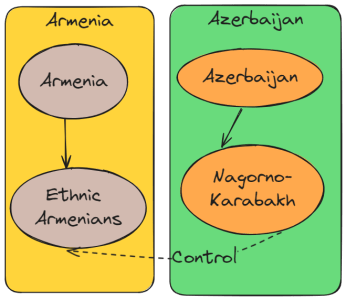Explanation :
d. None
North Kivu and Ituri Conflict – UPSC
The North Kivu and Ituri conflict refers to a complex and ongoing series of armed clashes, ethnic violence, and insurgencies in the Democratic Republic of the Congo (DRC). The roots of this conflict extend back decades and are intertwined with the broader history of violence and instability in the Great Lakes region of Africa.
Key Points
- Historical Context: Follows the Rwandan Genocide in 1994, with Hutu militias fleeing into the DRC, leading to the First and Second Congo Wars.
- Ethnic Tensions: High tensions between Hutu, Hema, Lendu, and Nande, with competition over land and resources contributing to violence and reprisal killings.
- Resource-Rich Area: Rich in minerals like gold, coltan, and diamonds, fueling the conflict as armed groups seek control for financing.
- Armed Groups: Various groups operate, including FDLR, ADF, and Mai-Mai militias, each with different agendas and support from regional and international actors.
- Humanitarian Crisis: Severe crisis with widespread displacement, human rights abuses, and a lack of basic services, leading to internal displacement and refugee flows.
- International and Regional Impact: Involvement of neighboring countries, UN peacekeeping forces like MONUSCO, and international efforts to address the crisis.
- Efforts for Peace: Despite peace agreements and disarmament efforts, the conflict persists due to its complexity and interplay of local and international issues.
Nagorno-Karabakh Conflict
Nagorno-Karabakh is a landlocked region in the South Caucasus that has been the subject of an intense and long-standing territorial dispute between Armenia and Azerbaijan. The area is predominantly inhabited by ethnic Armenians but is internationally recognized as part of Azerbaijan.

Historical Context
The roots of the conflict can be traced back to the early 20th century when both Armenia and Azerbaijan became part of the Soviet Union. Nagorno-Karabakh was established as an autonomous region within the Azerbaijan Soviet Socialist Republic, despite its majority Armenian population. Tensions between the two ethnic groups simmered for decades, with occasional outbreaks of violence.
War and Ceasefire
The conflict escalated into a full-scale war following the weakening of Soviet authority and the eventual dissolution of the USSR in 1991. Nagorno-Karabakh declared independence, leading to a war that lasted until a Russia-brokered ceasefire was established in 1994. Despite the ceasefire, the region’s status remained unresolved, and sporadic clashes continued. The war resulted in tens of thousands of deaths and the displacement of hundreds of thousands of people.
Renewed Conflict and Recent Developments
In 2020, a new outbreak of hostilities, known as the Second Nagorno-Karabakh War, resulted in significant military and civilian casualties. After six weeks of intense fighting, a trilateral agreement was signed by Armenia, Azerbaijan, and Russia to end the hostilities. Azerbaijan regained control of some territories held by Armenian forces, and Russian peacekeeping forces were deployed to the region.
Current Situation
The status of Nagorno-Karabakh remains a contentious issue. The 2020 ceasefire agreement has not resolved the fundamental dispute over the region’s sovereignty. While Azerbaijan insists on its territorial integrity, many ethnic Armenians in Nagorno-Karabakh and the Armenian government continue to seek recognition of the region’s independence or its unification with Armenia. The presence of Russian peacekeepers and ongoing negotiations aim to maintain stability and find a lasting resolution to the conflict. However, the future of Nagorno-Karabakh is still uncertain, and the region remains a flashpoint in the South Caucasus.
Kherson and Zaporizhzhia Regions in Southeastern Ukraine
Kherson
Kherson is a region (oblast) located in the southern part of Ukraine, north of the Crimean Peninsula annexed by Russia in 2014. The administrative center is the city of Kherson. Known for its agricultural productivity, the region grows fruits and vegetables due to fertile soil and a favorable climate. Kherson also has a significant industrial sector, including shipbuilding and food processing.
The region’s access to the Black Sea via the Dnipro River makes it a crucial transit point for maritime trade. Its proximity to the Crimean Peninsula adds strategic significance amid the ongoing conflict between Ukraine and Russia.
Zaporizhzhia
Zaporizhzhia, also spelled Zaporizhia, is another region in southeastern Ukraine, known for its rich history and industrial strength. The capital is the city of Zaporizhzhia, home to the DniproHES hydroelectric power plant, one of Europe’s largest. The region is a key industrial area with a focus on heavy industry, including steel production, aluminum, and machinery.
Historically significant as the homeland of the Cossacks, particularly the Zaporozhian Cossacks, the region played a vital role in the development of Ukrainian national identity. Its strategic location along the Dnipro River has been important for centuries.
Impact of Russian Invasion
Both Kherson and Zaporizhzhia have been significantly affected by the Russian invasion of Ukraine that began in 2014 and escalated in February 2022. These regions witnessed military conflict, occupation, and contested control, leading to human suffering, displacement, and damage to infrastructure and the local economy. The ongoing conflict has brought international attention to these regions, emphasizing their importance to Ukraine’s sovereignty and territorial integrity.